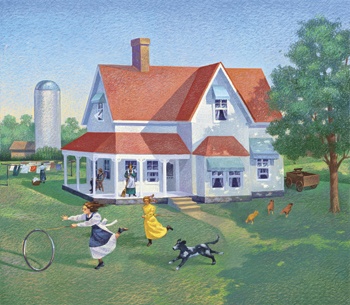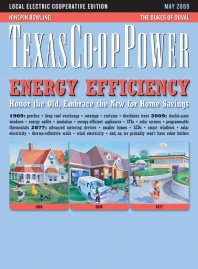Some home improvement investments—the ones that reduce your utility bills—are more important than ever. It’s pretty clear to see that the age of excess is over. We are all on our way to becoming smart energy users—if not outright misers. Our aim here is to provide a brief overview of projects, designs and products for increasing home efficiency and comfort. We’ll look at old and new ideas as well as some emerging technologies that we hope to see in the market in the near future.
Some investments pay off better than others. It may not be cost-effective to spend the money for window replacements. They are expensive, and many other improvements can be made more affordably. The first step in deciding what’s feasible for your home is to get an energy audit or learn to perform an audit yourself. We’ll say it again: Get an energy audit. Many cooperatives do energy audits or will guide you to other professionals who do them. Audits vary in scope, but their primary intent is to identify your problems and come up with solutions. Often, some of the greatest savings involve relatively low-cost repairs. This especially is the case with older homes. For expenditures of $2,000 or less on weatherization, some households can save more than $1,000 annually on electricity costs, experts say.
Before beginning weatherization or any other improvement project, check with your co-op, city conservation officials and the state energy office. They can provide advice on local contractors and suppliers and information on incentives and rebates available in your area.
Some things old
Your grandparents and great-grandparents knew what they were doing. The design and orientation of their homes was crucial in creating a comfortable living space before the advent of centralized heating and cooling. Thanks to the current trend in green building, attention has again been placed on these time-tested methods. Homes designed around the conditions in which they are built not only use less energy, but they also are more comfortable. Consider some basic principles of design and orientation from the following examples:
- Homes designed for warmer regions —where the majority of energy consumption is spent on cooling—emphasize shading and passive ventilation. They are long and narrow, minimizing exposure from the east and west where the sun is most direct.
- Windows are minimal on these sides for the same reason.
- Porches and deep roof overhangs offer protection against the harsh summer sun.
- Awnings shade windows and walls. Curtains are drawn during the summer heat and winter cold.
- Deciduous trees shade the east and west walls. In winter, when trees lose their leaves, the house benefits from the sun’s warmth.
- Higher ceilings allow heat to rise above occupants.
- Light exterior colors reflect the sun’s heat.
Some things new
- Sealing and insulating are not exactly new, but they remain the most important step in improving a home’s efficiency. Use weatherstripping around windows and doors and caulk and spray foam around window frames, pipes, fixtures and other gaps. Attic floor insulation is typically the most cost-effective investment whether you do it yourself or hire someone to do it for you. Don’t forget to seal and insulate ductwork as well. For the benefit of your health, consider using sealants that are low in volatile organic compounds (VOCs) and a form of formaldehyde-free insulation. VOCs are emitted as gases from certain solids or liquids and include a variety of chemicals, some of which may have short- and long-term adverse health effects.
- Compact fluorescent lamps (CFLs) are profoundly more efficient than traditional incandescent lightbulbs, which waste up to 90 percent of the electricity they consume in creating heat. An estimated $25 to $45 can be saved per CFL over its lifetime. The newest generation of CFLs is finally coming of age and even includes dimmable bulbs. Stick with 2700K (Kelvin) lights—Kelvin, a unit increment of temperature, measures the color temperature of light sources —for interiors to best match the warmth of incandescent bulbs.
- Programmable thermostats offer one of the easiest and most affordable ways to save energy at home. They can save almost $200 per year by reducing household heating and cooling at times when it’s not needed.
- Tankless water heaters save energy by operating only when hot water is needed. They have the added benefit of taking up much less space, allowing homeowners to partly reclaim closets taken up by bulky, traditional tanks. A low-cost alternative is to add a tank “blanket” to existing water tanks so they will lose less heat.
- High-tech double- and triple-pane windows with low-emissivity (low-E) coatings—virtually invisible layers of metal or metallic oxide that reduce the amount of heat that passes through the glass—are vastly more efficient than single-pane windows. For this reason, replacing windows is often a top choice when considering major renovations. Such windows are very expensive and should be much lower on your priority list than good old caulking and insulation. For a low-cost alternative, apply a low-E film to existing windows. It is effective both in reflecting unwanted heat in summer and in retaining heat in winter and is widely available as a do-it-yourself kit. Solar screens are still another choice and are particularly appropriate for large, scenic windows. Exterior applications are far more effective in blocking heat.
- Advanced direct-vent, sealed-combustion stoves have revolutionized fireplaces in homes. Unlike conventional fireplaces, which can actually lose more energy than they generate by drawing interior air up the chimney, this new breed of stoves reaches about 90 percent efficiency. Since the stoves are vented directly to the outside through a hole in an exterior wall, there is no need to construct a chimney or run a freestanding flue above the roofline. These stoves are available as inserts for existing fireplaces and can be fueled by gas, wood or pellets.
Some things future
- Advanced metering devices—Many co-ops currently use digital metering to record electricity use and locate problems on lines. Some meters have two-way communication. In the future, such electronic communication tools will be more sophisticated so customers can determine when they use the most electricity and where they might reduce consumption. Time-of-day metering or rebates will probably be in effect to discourage electricity use during peak hours. Appliances will be programmable for use in non-peak hours.
- Light-emitting diodes (LEDs)—Home applications of LEDs now are found mainly in flashlights and task lights. With a lifespan of approximately 60,000 hours—as compared to CFLs’ 10,000 hours and incandescent bulbs’ 1,500 hours—LEDs are a product with a great future. The market is waiting for costs to decrease.
- Thin-film solar photovoltaics (PVs), like conventional PVs, convert sunlight into electricity. They improve on conventional PVs by being lightweight, flexible and, most importantly, far cheaper to produce. Expect to see a variety of home-related products from several manufacturers in the next two to three years. Many believe that the greatest advancements in future solar technology will involve the use of quantum dots—tiny semiconductors that use the unique light-harvesting properties of nano-sized crystals. The science is complicated, but the result is a theoretical doubling in efficiency (estimations are as high as 65 percent) for quantum-dot solar cells—as compared to today’s most efficient cells. Preliminary experiments suggest that quantum dot cells could be produced with relatively low material costs.
- Smart windows work a lot like those funny eyeglasses that tint in the sun and then change back to clear indoors. In the case of electrochromic windows—electronically tintable glass that can be switched from clear to darkly tinted, and vice versa—the glass responds to an electrical current that can be controlled by a switch, light sensors, thermostats or even a motion sensor. New designs—including ones that use integrated solar cells to produce power—promise greater efficiency. Thermo-reflective windows are activated only by heat, and, according to the manufacturer, they are superior in stopping heat from entering a building. Because they respond only to heat, the windows let in more heat (and light) in cold weather and block it in warm weather. The manufacturer uses a similar approach toward managing heat with an advanced thermo- reflective wall or cladding technology that can be “programmed” at the time of manufacture to reflect heat at a specific temperature.
——————–
Jody Horton, an Austin-based freelancer, specializes in writing about green building.


